How Do You Know if Its Ionic or Covalent
four.7: Which Bonds are Ionic and Which are Covalent?
- Folio ID
- 191160
Cells contain lots of h2o. One of the roles of the water is to dissolve different materials. For example, there are many different ionic compounds (salts) in cells. Ions are used to maintain jail cell potentials and are important in cell signaling and muscle contraction.
How tin you tell if a chemical compound is ionic or covalent?
There is not a elementary answer to this question. Many bonds are somewhere in between. In a polar covalent bond, a pair of electrons is shared between 2 atoms in order to fulfill their octets, simply the electrons lie closer to one cease of the bail than the other. There is more negative charge toward ane cease of the bond, and that leaves more positive accuse at the other stop.
Looking at the electronegativity values of different atoms helps us to make up one's mind how evenly a pair of electrons in a bail is shared. Electronegativity increases toward the upper right paw corner of the periodic tabular array because of a combination of nuclear charge and shielding factors. Atoms in the upper correct hand corner of the periodic table have a greater pull on their shared bonding electrons, while those in the lower left hand corner take a weaker allure for the electrons in covalent bonds.
In a carbon-oxygen bail, more than electrons would exist attracted to the oxygen because information technology is to the right of carbon in its row in the periodic table. Compounds similar , dimethyl ether, CH3OCHthree, are a trivial bit polar. Formaldehyde, CH2O, is even more polar. Electrons in pi bonds are held more loosely than electrons in sigma bonds, for reasons involving quantum mechanics. That allows the oxygen to pull the electrons toward it more easily in a multiple bond than in a sigma bond.

Not all polarities are easy to make up one's mind by glancing at the periodic table. The direction of the dipole in a boron-hydrogen bail would be difficult to predict without looking upward the electronegativity values, since boron is further to the correct but hydrogen is higher upwards. As information technology turns out, the hydrogen is slightly negative.
A bail is ionic if the electronegativity difference betwixt the atoms is great enough that ane cantlet could pull an electron completely abroad from the other 1. That situation is common in compounds that combine elements from the left-hand edge of the periodic table (sodium, potassium, calcium, etc.) with elements in the farthermost upper right hand corner of the periodic table (most commonly oxygen, fluorine, chlorine). Sodium chloride is an ionic compound.
Many bonds can be covalent in 1 situation and ionic in another. For example, hydrogen chloride, HCl, is a gas in which the hydrogen and chlorine are covalently jump, but if HCl is bubbled into water, information technology ionizes completely to give the H+ and Cl- of a hydrochloric acid solution. Even in gaseous HCl, the charge is not distributed evenly. The chlorine is partially negative and the hydrogen is partially positive.
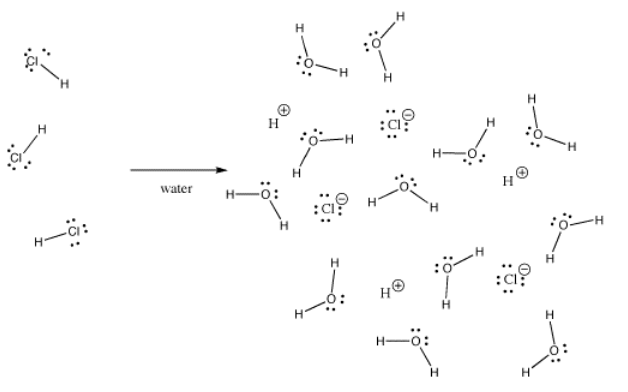
Potassium hydroxide, KOH, contains one bail that is covalent (O-H) and one that is ionic (K-O). Hydrogen is tricky because information technology is at the acme of the periodic table besides as the left side. It is just electropositive enough to grade ionic bonds in some cases. It is just electronegative enough to form covalent bonds in other cases.
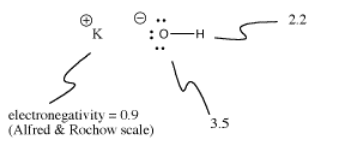
In KOH, the K-O bond is ionic considering the difference in electronegativity between potassium and oxygen is large. The difference in electronegativity between oxygen and hydrogen is non small. An O-H bond can sometimes ionize, merely not in all cases.
Sometimes ionization depends on what else is going on within a molecule. Because the 1000-O bail in potassium hydroxide is ionic, the O-H bail is not very likely to ionize. There is already a negative charge on oxygen. Charge separation costs energy, so it is more difficult to put a second negative accuse on the oxygen by ionizing the O-H bail as well. Often first ionizations in molecules are much easier than 2nd ionizations.
Exercise \(\PageIndex{i}\)
Predict the management of polarity in a bond between the atoms in the following pairs:
a) sulfur-oxygen b) silicon-fluorine
c) hydrogen-sodium d) chlorine-aluminum
- Answer
-
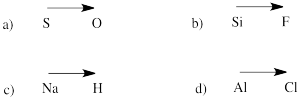
Considering it is then mutual that an element from the extreme left paw of the periodic table is nowadays as a cation, and that elements on the extreme correct carry negative charge, we can often assume that a compound containing an example of each will accept at least i ionic bail.
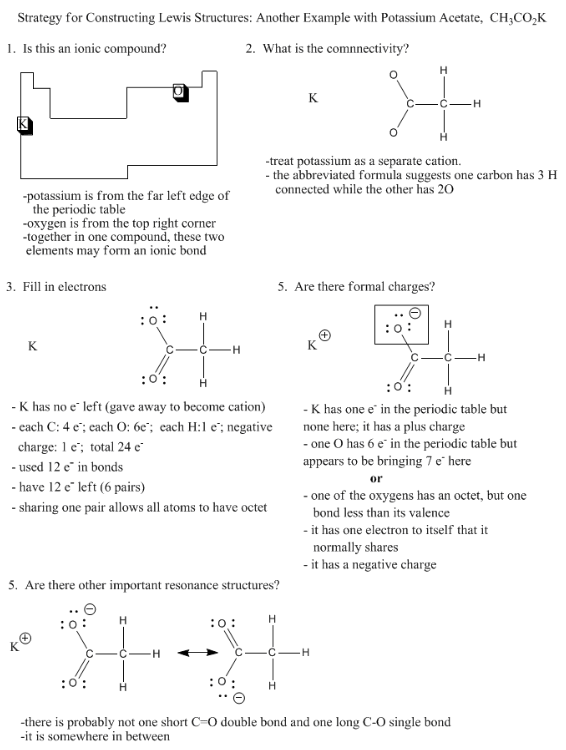
Practise \(\PageIndex{2}\)
Draw structures of the post-obit compounds. Each one contains at least one anion and cation.
a) KBr b) LiOH c) KNO3 d) MgSO4 e) Na3PO4 f) Na2And so3
thousand) LiClO4 h) NaClOthree i) KNOii j) Ca(ClO2)2 grand) CatwoSiO4 50) Na3POiii
m) NaOCl northward) MgtwoSnO4
- Answer
-
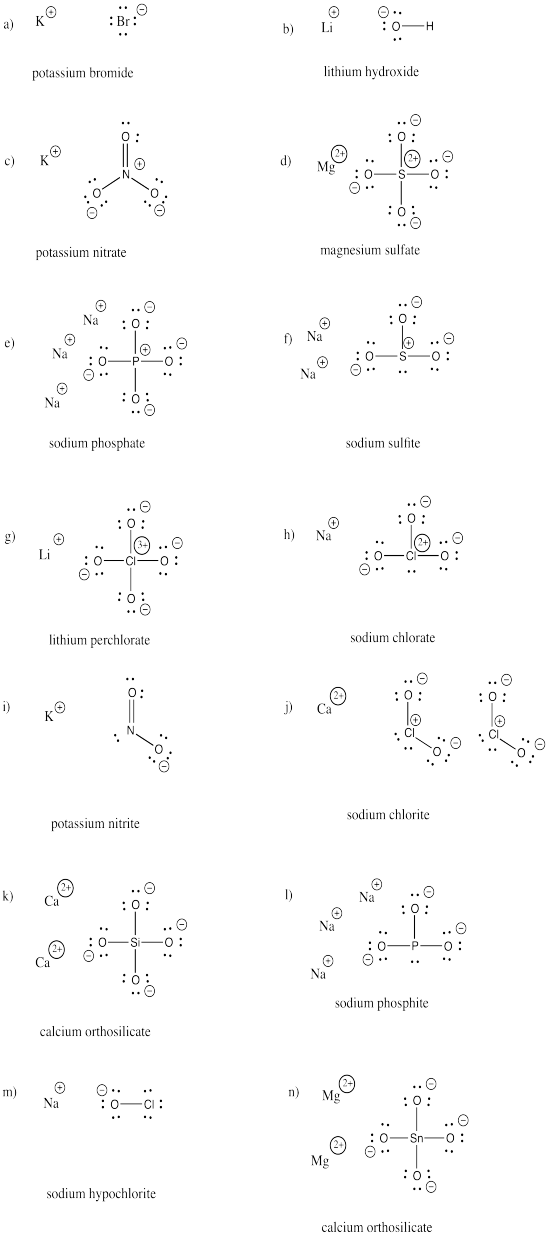
Exercise \(\PageIndex{three}\)
Ammonium ion, NH4 +, is a common molecular ion. Draw structures for the post-obit compounds that include this ion.
a) NH4Cl b) (NH4)2CO3 c) (NHiv)3PO3 d) NHivCHiiiCOii e) NH4HSOfour
- Answer
-
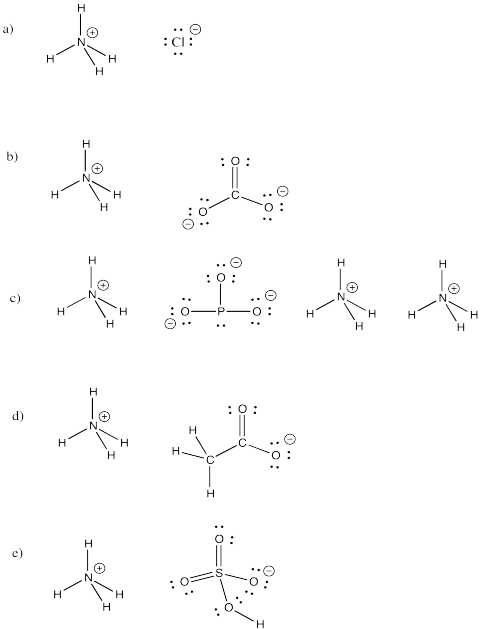
Exercise \(\PageIndex{4}\)
Many anions accept names that tell you something about their structure.
| prefix- or -suffix | common meaning | example proper noun | example formula |
| -ide | atom is present as anion | chloride | Cl - |
| -ate | cantlet is nowadays equally an oxyanion; unremarkably a common form | chlorate | ClOthree - |
| -ite | atom is present equally an oxyanion, only with fewer oxygens (or lower "oxidation state") than another common form | chlorite | ClOtwo - |
| per- | atom is nowadays equally an oxyanion, only with even more oxygens than the "-ate" grade | perchlorate | ClO4 - |
| hypo- | atom is present as an oxyanion, just with fifty-fifty fewer oxygens than the "-ite" form | hypochlorite | ClO- |
Using the tabular array equally a guide, propose names for the post-obit anions:
a) Br- b) O2- c) F- d) COiii 2- (common oxyanion) e) NO3 - (mutual oxyanion) f) NOii -
g) S2- h) SO4 2- (common oxanin) i) SOiii 2- j) SOfive two- grand) C4- fifty) Northward3- m) Equally3-
n) PO4 iii- (mutual oxyanion) o) PO3 3- p) I- q) IO3 - (common oxyanion) r) IOiv -
- Answer a
-
bromide
- Answer b
-
oxide
- Answer c
-
fluoride
- Reply d
-
carbonate
- Answer east
-
nitrate
- Respond f
-
nitrite
- Answer g
-
sulfide
- Answer h
-
sulfate
- Answer i
-
sulfite
- Answer j
-
persulfate
- Answer k
-
carbide
- Answer l
-
nitride
- Answer k
-
arsenide
- Answer northward
-
phosphate
- Respond o
-
phosphite
- Reply p
-
iodide
- Respond q
-
iodate
- Answer r
-
periodate
Source: https://chem.libretexts.org/Bookshelves/General_Chemistry/Book%3A_Structure_and_Reactivity_in_Organic_Biological_and_Inorganic_Chemistry_(Schaller)/I%3A__Chemical_Structure_and_Properties/04%3A_Introduction_to_Molecules/4.07%3A_Which_Bonds_are_Ionic_and_Which_are_Covalent

0 Response to "How Do You Know if Its Ionic or Covalent"
Post a Comment